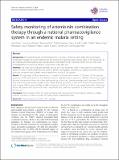| dc.contributor.author | Thiam, Sylla | |
| dc.contributor.author | Ndiaye, Jean-Louis | |
| dc.contributor.author | Diallo, Ibrahima | |
| dc.contributor.author | Gatonga, Patrick | |
| dc.contributor.author | Fall, Fatou Ba | |
| dc.contributor.author | Diallo, Ndella E | |
| dc.contributor.author | Faye, Babacar | |
| dc.contributor.author | Diouf, Mamadou L | |
| dc.contributor.author | Ndiop, Medoune | |
| dc.contributor.author | Diouf, Mame B | |
| dc.contributor.author | Gaye, Oumar | |
| dc.contributor.author | Thior, Moussa | |
| dc.date.accessioned | 2021-08-27T12:36:27Z | |
| dc.date.available | 2021-08-27T12:36:27Z | |
| dc.date.issued | 2/5/2013 | |
| dc.identifier.citation | Thiam, S., Ndiaye, JL., Diallo, I. et al. Safety monitoring of artemisinin combination therapy through a national pharmacovigilance system in an endemic malaria setting. Malar J 12, 54 (2013). https://doi.org/10.1186/1475-2875-12-54 | en_US |
| dc.identifier.issn | 1475-2875 | |
| dc.identifier.uri | http://repository.amref.org/handle/123456789/169 | |
| dc.description | This article is published under license to BioMed Central Ltd. This is an Open Access article distributed under the terms of the Creative Commons Attribution License (http://creativecommons.org/licenses/by/2.0), which permits unrestricted use, distribution, and reproduction in any medium, provided the original work is properly cited. | en_US |
| dc.description.abstract | Background
The National Malaria Control Programme in Senegal, introduced since 2006, artemisinin-based combination therapy (ACT administration) for the treatment of uncomplicated malaria cases. In this framework, an anti-malarial pharmacovigilance plan was developed and implemented in all public health services. This study investigated the occurrence of Adverse Drug Events (ADEs) after ACT.
Methods
The study was conducted between January 2007 and December 2009. It was based on spontaneous reports of ADEs in public health facilities. Data on patient demographic characteristics, dispensing facility, adverse signs and symptoms and causality were collected from a total of 123 patients.
Results
The age range of these patients was six months to 93 years with a mean of 25.9 years. Of the reported symptoms, 46.7% were related to the abdomen and the digestive system. Symptoms related to the nervous system, skin and subcutaneous tissue, circulatory and respiratory systems and general symptoms and signs were 7%, 9.7%, 3.5% and 31.3%, respectively. Causality results linked 14.3% of symptoms to Falcimon® (Artesunate-Amodiaquine) with certainty. Effects were classified as mild and severe in 69.1% and 7.3% of cases respectively while 23.6% were serious. All patients with serious ADEs were hospitalized. One death was reported in a patient who had taken 24 pills at once.
Conclusion
These results confirm the need to develop and implement pharmacovigilance systems in malaria endemic countries in order to monitor the safety of anti-malarial treatments. | en_US |
| dc.language.iso | en | en_US |
| dc.publisher | BioMed Central | en_US |
| dc.subject | artemisinin-based combination therapy | en_US |
| dc.subject | ACT | en_US |
| dc.subject | Anti-malarial | en_US |
| dc.subject | Adverse Drug Events (ADEs) | en_US |
| dc.subject | public health facilities | en_US |
| dc.subject | Malaria | en_US |
| dc.subject | chloroquine | en_US |
| dc.subject | artesunate-amodiaquine (AS-AQ) | en_US |
| dc.subject | artemether-lumefantrine (AL) | en_US |
| dc.subject | Global Fund | en_US |
| dc.subject | AIDS | en_US |
| dc.title | Safety monitoring of artemisinin combination therapy through a national pharmacovigilance system in an endemic malaria setting | en_US |
| dc.type | Article, Journal | en_US |

